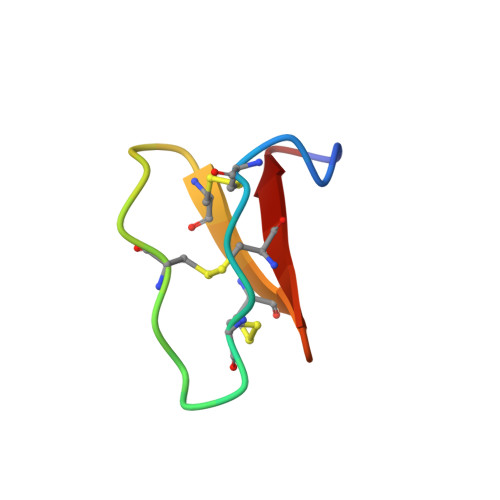Importance of the Cyclic Cystine Knot Structural Motif for Immunosuppressive Effects of Cyclotides.
Hellinger, R., Muratspahic, E., Devi, S., Koehbach, J., Vasileva, M., Harvey, P.J., Craik, D.J., Grundemann, C., Gruber, C.W.(2021) ACS Chem Biol 16: 2373-2386
- PubMed: 34592097
- DOI: https://doi.org/10.1021/acschembio.1c00524
- Primary Citation of Related Structures:
7LHC, 7RFA - PubMed Abstract:
The cyclotide T20K inhibits the proliferation of human immune cells and is currently in clinical trials for multiple sclerosis. Here, we provide novel functional data and mechanistic insights into structure-activity relationships of T20K. Analogs with partial or complete reduction of the cystine knot had loss of function in proliferation experiments. Similarly, an acyclic analog of T20K was inactive in lymphocyte bioassays. The lack of activity of non-native peptide analogs appears to be associated with the ability of cyclotides to interact with and penetrate cell membranes, since cellular uptake studies demonstrated fast fractional transfer only of the native peptide into the cytosol of human immune cells. Therefore, structural differences between cyclic and linear native folded peptides were investigated by NMR to elucidate structure-activity relationships. Acyclic T20K had a less rigid backbone and considerable structural changes in loops 1 and 6 compared to the native cyclic T20K, supporting the idea that the cyclic cystine knot motif is a unique bioactive scaffold. This study provides evidence that this structural motif in cyclotides governs bioactivity, interactions with and transport across biological membranes, and the structural integrity of these peptides. These observations could be useful to understand the structure-activity of other cystine knot proteins due to the structural conservation of the cystine knot motif across evolution and to provide guidance for the design of novel cyclic cysteine-stabilized molecules.
Organizational Affiliation:
Center for Physiology and Pharmacology, Medical University of Vienna, Schwarzspanierstr. 17, Vienna 1090, Austria.














